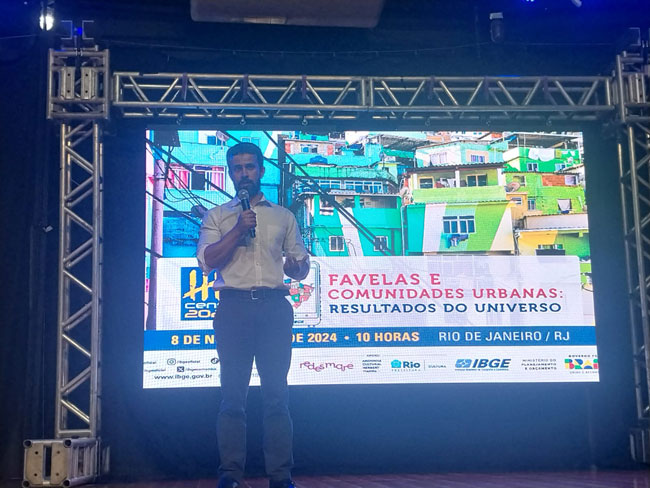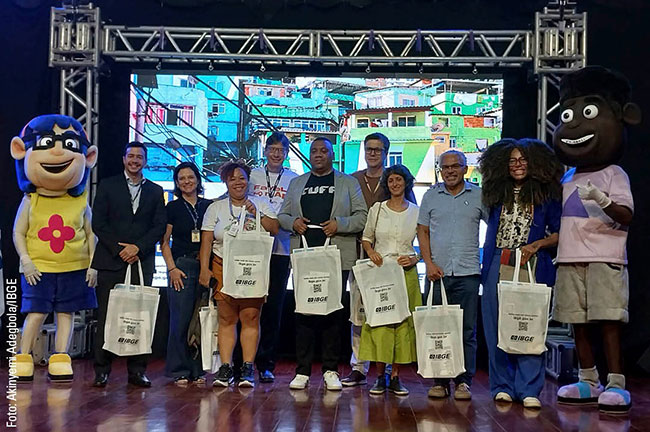2022 Census
2022 Census: In Maré (RJ), IBGE releases data about Favelas and Urban Communities
November 08, 2024 07h21 PM | Last Updated: November 12, 2024 12h16 PM

The Brazilian Institute of Geography and Statistics (IBGE) released, on Friday, 8, data relative to the “2022 Population Census: Favelas and Urban Communities: population Results” at Areninha Cultural Herbert Vianna, located in Favela Nova Maré, in the north zone of Rio de Janeiro (RJ). The event was attended by more than 100 people, including IBGE civil servants, authorities and members of civil society and of Maré, and was streamed live on Digital IBGE and on the Institute's social networks.

Attended by the president of the Institute, Marcio Pochmann, the director of Geosciences, Ivone Lopes Batista, the director of Surveys, Elizabeth Hypólito, the coordinator general of the Population Census, Gustavo Junger, and by the researchers Letícia Giannella and Larissa Catalá, the president was mediated by the coordinator general of the Center for Information Documentation and Dissemination and of Social Communication (CDDI/CCS), José Daniel Castro, together with Pâmela Carvalho, a local resident and coordinator of the Maré Women Network.
 Pâmela Carvalho as mediator of the roundtable with community leaders - Photo: Akinyemi Adesola/IBGE
Pâmela Carvalho as mediator of the roundtable with community leaders - Photo: Akinyemi Adesola/IBGE
The president of Central Única das Favelas (CUFA) Rio de Janeiro, Francisco de Lima (Preto Zezé), community leaders, ministry representatives and members of Oswaldo Cruz Foundation (Fiocruz) and of Instituto Pereira Passos (IPP) also attended the release.
Pochmann highlighted the reason for having the IBGE present at this release in Complexo da Maré. “We came here for the 2022 Census and now we come back to give information back as results, which is only possible thanks to the 11 thousand plus civil servants working in more than 500 branches,” said the president of the Institute.
He also reinforced that “being here in such an important place not only for Rio de Janeiro, but for Brazil as a whole shows that these data are part of a greater transformation process.”

Preto Zezé remarked on the partnership between CUFA and the IBGE to improve data, expand surveys and convince the population from favelas to answer the questionnaires. “these pieces of information are essential to give visibility to groups that live in these territories and call the attention of public authorities to promote policies more directed to people who live here,” said the president of CUFA.

Anderson Quack, head of the Advisory in Social Participation and Diversity for the Ministry of Planning and Budget, congratulated, during a video call, the IBGE for this release. “Our ministry is committed to the Census and its released data, for, without them, it is impossible to create public policies, and the private initiative faces difficulties in generating employment and income among the population. This is a historical day in Brazil.”

Eduardo Medeiros do Santos is a public policies analyst at the regional Superintendence of Labor and Employment in the State of Rio de Janeiro and attended the event on behalf of the state government, Luiz Marinho. According to the analyst, it is essential to have these data in the formulation of public policies. “I praise the work of the IBGE of visiting the home of every family and feeling this reality. That is fundamental as no public policy can be implemented without a discussion with society.”
The special advisor for the Ministry of Health, Valcler Rangel, regards the IBGE as property of the country: “the presence of the Institute in Instituto in Complexo da Maré is essential, it plays a reparation role for the residents of the favela. These data present invaluable material for the conduction of public policies.”
The IBGE’s director of Geosciences, Ivone Lopes Batista mentioned the importance of this theme and the change in the nomenclature adopted by the Institute, from “subnormal clusters” to “favelas and urban communities.” “It is good we have come to this construction both conceptually and in terms of data survey. So we thank the support of social movements, city administrations and the technical team for the hard work in the collection of these data. These data are not only important for the formulation of public policies, but also for the access of the community.”
Elizabeth Hypólito, director of Surveys of the Institute, highlighted as the Census is a big and complex survey, which allows the dissemination of data such as those released today: “These is relevant information for the government, and for society so that it feels represented and in the full exercise of its citizenship and rights,” explained the director.

Gustavo Junger thanked the IBGE technical teams for their dedication, also mentioning the enumerators who took part in the process, and everyone who opened their doors to answer the Census. “Today we see the return of these results and see the extreme importance of all those who have taken part in this process,” said the technical Coordinator of the Census.

Júlia Lins, representative of the National Secretariat for Peripheries highlighted the relevance of this release taking place in Maré. “That shows the IBGE’s will understand what is taking place in these territories; the change of nomenclature is an indication of this process. The Institute also advances as it allows communities to name themselves.”
Favelas and urban communities
A researcher at the IBGE, Letícia Giannella is a representative of the Department of Social Territories within the Coordination of Geography and presented data related to the number of favelas and urban communities in the country, disaggregated by sex, age, color or race and illiteracy rate. The 2022 Census found a total of 12,348 Favelas and Urban Communities, inhabited by 16,390,815 persons, which was equivalent to 8.1% of the country’s population, distributed among 656 municipalities. For further information see the publication released on November 8.
“The most populous favela is Rocinha, in Rio de Janeiro (RJ), with 72,021 residents, followed by Sol Nascente, in Brasília (DF), with 70,908 residents and Paraisópolis, in São Paulo (SP), with 58,527 people,” said Giannella.
As for number of housing units, something similar is observed. “Sol Nascente, in Brasília (DF), with the second biggest resident population, was number three regarding number of housing units (21,889). And in the second position of this ranking was Rio das Pedras, in Rio de Janeiro (RJ), with 23,846 housing units. This favela is the fifth most populous in the country, with 55,653 residents,” said Letícia Catalá, a member of the survey technical team.
Catalá also presented the characteristics of housing units in the favelas. “93.3% of the housing units are houses, whereas 2.8% are apartments and other 2.8% are apartments and other 2.8% are in shared yards or condos.”
She highlighted that “in 2022, 83.9% of all the occupied permanent private housing units were connected to the general supply system and used it as main form of supply. Among the occupied permanent private housing units in Favelas and Urban Communities, this percentage was 86.4%”.
Community leaders attend the release of Census data
Dalcio Marinho is coordinator of Maré Census, an initiative by Maré Networks in partnership the Observatory of Favelas mentioned the honor of receiving the IBGE there. “This release is essencial for Maré. Here is a group of 16 favelas, being 15 them continuous ones. Their total population is bigger than that of 96% of the municipalities in Brazil. Being seen by the IBGE is essential and the result of our mobilization as residents.

A leader of the Maré Women’s Movement, Dona Margareth explained that there was a struggle to guarantee basic sanitation and public lighting for the territory, as it is the case in most favelas that provided Census data. “It is an arduous struggle and having data like these today causes authorities look at us.”

Flávia Cândido is a representative of the Full Health project in the favelas of Rio de Janeiro and highlighted that all the data handed by the IBGE will “give visibility to people who live in the favelas and call the attention of authorities for the creation of policies that make population’s lives better”.





















